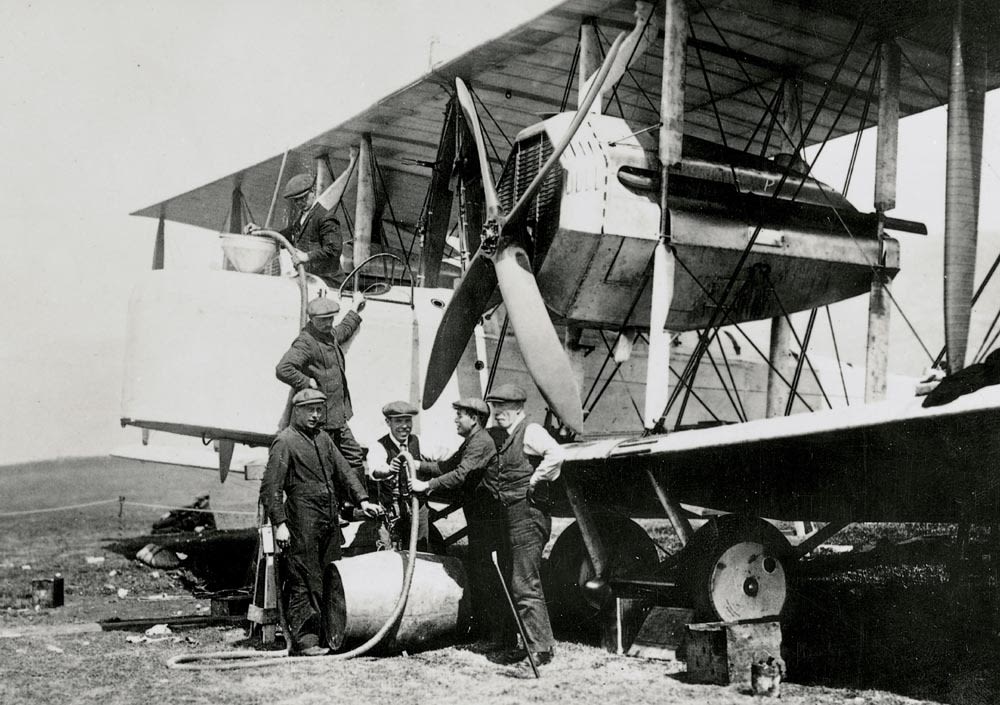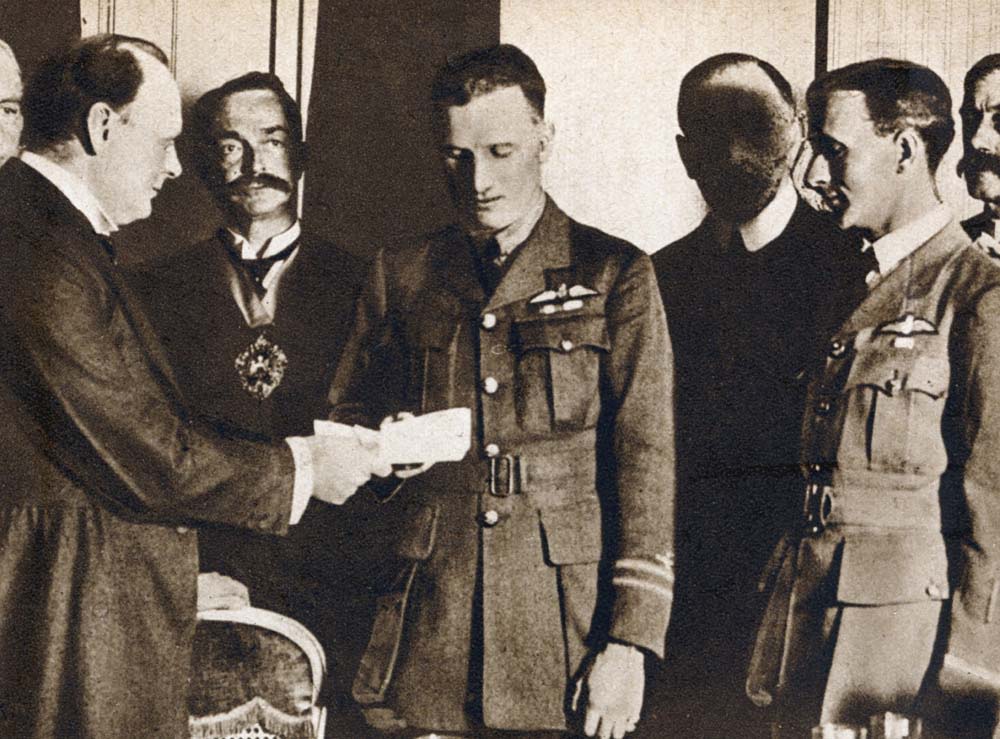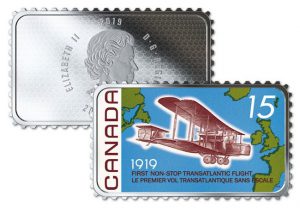Posts by Alex
How a £10,000 reward led to one of the greatest advancements in aviation
In the 1800’s, when aeroplanes were a mere twinkle in the eye of ambitious engineers, the idea of transatlantic flight came about with the advent of the hot air balloon. But one crash-landing, and one postponement due to the American Civil War meant this dream had to go back to the drawing board.
On the other side of the pond, in April of 1913 The Daily Mail newspaper offered a cash prize of £10,000 to “the aviator who shall first cross the Atlantic in an aeroplane in flight from any point in the United States of America, Canada or Newfoundland and any point in Great Britain or Ireland in 72 continuous hours”.
But it wasn’t until after the end of WWII that transatlantic flight by aircraft became truly viable, thanks to the significant advancements in aerial capabilities and technology.
Then the competition really heated up…
Nail-biting four-way competition
What came was a nail-biting four-way contest against the clock as well as each other. Four different ‘teams’ formed and went to work to try and prepare their chosen aircraft the fastest, for fear of being pipped to the post by another team making their attempt sooner. To make it a fair contest, each team had to ship their aircraft to Newfoundland for the take-off.
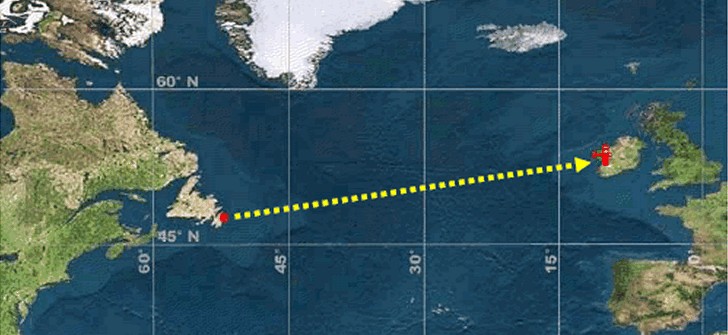
First to try was Australian pilot Harry Hawker and navigator Kenneth Mackenzie Grieve, piloting a Sopwith Atlantic – an experimental British long-range aircraft. In flight the aircraft suffered from engine failure and, when coupled with poor weather conditions, the decision was made to abort the mission.
The aircraft was abandoned in the Atlantic Ocean, 750 miles from Ireland, and the pair were rescued by a Danish steamer SS Mary. Due to the SS Mary not having any radio contact, the pair were presumed dead and King George V sent a telegram of condolence, but luckily this wasn’t the case as the pair arrived back on land nearly a week later.
The next attempt wasn’t nearly as exciting, as the aircraft never left the take-off zone. Frederick Raynham and C. W. F. Morgan made the attempt in a Martinsyde but crashed on take-off due to the heavy fuel load.
Then came the turn of aviator duo, John Alcock and Arthur Brown, who flew straight into the history books on June 15th 1919…
Flying in to the unknown across the Atlantic
The Vickers engineering and aviation firm, which had considered entering its Vickers Vimy IV twin-engine bomber in the competition, appointed Alcock as the team’s pilot along with Brown who was adept at long-distance navigation.

In preparation for the transatlantic flight, The Vimy, powered by two Rolls-Royce Eagle 360 hp engines, was successfully converted, including replacing its bomb racks with extra petrol tanks.
The pair took off from St. John’s, Newfoundland, in their modified bomber around 1:45pm on 14th June 1919. To say it wasn’t an easy flight would be an understatement. They encountered both mechanical and natural challenges. The wind-powered generator failed, depriving them of radio contact and much needed heating in their open-top cockpit. Fog and a snowstorm prevented navigation, almost resulting in a crash-landing at sea, not to mention the snow and freezing conditions meant the engines were in danger of icing up.
Whilst they were set a 72-hour target by The Daily Mail, the duo made landfall in Clifden, County Galway, in Ireland at 8:40am on 15th June 1919 – after just 16 hours of flight!
Incredibly, they landed not far from their intended landing zone in Ireland. However, the aircraft was damaged upon arrival because what looked like a field from their aerial view turned out to be a bog, causing the aircraft to nose-over. Thankfully neither were hurt, and Brown claimed that if the weather had been good, they’d have been able to continue to London.
A hero’s return to a £10,000 reward
Alcock and Brown’s successful attempt meant that the fourth team, Handley Page Limited, who were yet to take-off, were no longer eligible to compete. The two airmen returned home as aviation heroes and pioneers of the sky.
As promised, Alcock and Brown were rewarded for their ground-breaking achievement – the £10,000 prize money offered by The Daily Mail, for the first crossing of the Atlantic in less than 72 consecutive hours.
The Secretary of State for Air at the time, Winston Churchill, presented the pair with their cash reward. Then one week later, at Windsor Castle, they were awarded the honour of Knight Commander of the Most Excellent Order of the British Empire by King George V.
If you’re interested…
The Royal Canadian Mint marked the milestone 100th anniversary of this remarkable achievement and feat of engineering with a limited edition 1oz Silver Proof coin. The coin features a faithful colour reproduction of the commemorative stamp that was issued to mark the 50th anniversary.
Unsurprisingly the coin proved so popular that it is no longer available at the Mint! We have a limited number remaining, click here for more information >>
Uncovering the British discoveries that inspired the Dinosaur 50p coins
I’ve always loved dinosaurs. As a child I’d be glued to the TV watching The Land Before Time and Jurassic Park, and I lost count of the number of family outings to the Jurassic Coast just so I could comb the beaches looking for fossils – I found a few ammonites, but alas no dinosaur bones!
The fact that their time on Earth remains mostly a mystery has fuelled our fascination with them for years. So, I’m sure many collectors shared my excitement when The Royal Mint announced a new UK 50p coin series dedicated to the celebration of dinosaurs. And if you’re a dinosaur enthusiast like me, I’m sure you’ll appreciate the special design details of these coins, that pay tribute to the British discoveries at every possible turn…
Dinosauria
What you may not know is that whilst fossils have been found on every continent on Earth, the study of dinosaurs actually started right here in the UK. In fact, over 50 to 60 species have been discovered beneath out feet.
The term ‘dinosaur’ that we use today comes from the term ‘Dinosauria’, which was coined by British Anatomist Richard Owen in a paper published in 1842. Owen was the first to realise that the remains of three creatures found in various locations within the UK shared common characteristics.

To celebrate Owen’s ground-breaking conclusion, the first three creatures that led him to his discovery have been featured on a UK 50p. Issued in collaboration with the Natural History Museum each one has been expertly brought-back to life by palaeo-artist Robert Nicholls.
Megalosaurus
Megalosaurus comes from the Greek for ‘great lizard’, and at seven to eight metres long it certainly lives up to its name! In terms of its appearance it can be compared to a T-Rex and comes from the same family of large carnivorous dinosaurs that can walk on two legs.
The Megalosaurus is the first dinosaur to ever be officially named in scientific literature. It’s thought that the earliest evidence of a Megalosaurus was found as early as the 17th century, but it wasn’t until years after it was first discovered that it was termed a dinosaur.
It was in 1824 that palaeontologist William Buckland produced the first scientific description of a Megalosaurus, based on fragments of jaw and bone found in Oxfordshire. This is the first non-aviation dinosaur to be formally named.
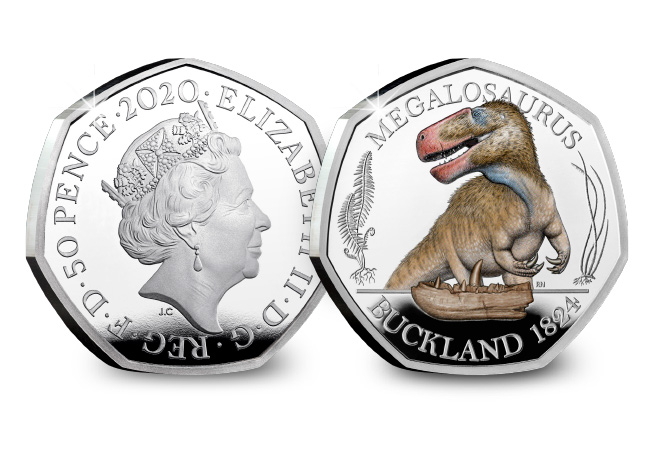
You’ll notice on the 50p coin that the Megalosaurus is framed by a jaw fragment, as a nod to the fossil that gave Buckland his breakthrough. Likewise, Buckland is featured, as is the year of the discovery, 1824.
Iguanodon
It was in 1822 that Mary Mantell spied a large tooth at the side of the road in Sussex, and upon pulling over realised it belonged to an unknown creature. Her husband, Geologist Dr Gideon Mantell, noticed that the tooth was similar to that of an iguana, and later in 1825 came to call it an Iguanodon. This was the second dinosaur species to receive its name.
It wasn’t until several years later in 1834, when an explosion in Maidstone revealed fragments of an ancient skeleton that Mantell could conceptualise what an Iguanodon may have looked like.
As well as distinctive iguana-like teeth, other distinctive features of an Iguanodon include its large thumb spikes, which were possibly used for defence against predators, combined with long fifth fingers capable of grasping, allowing them to forage for food. The creatures belong to the dinosaur family of medium-sized herbivores that usually walked on two legs.
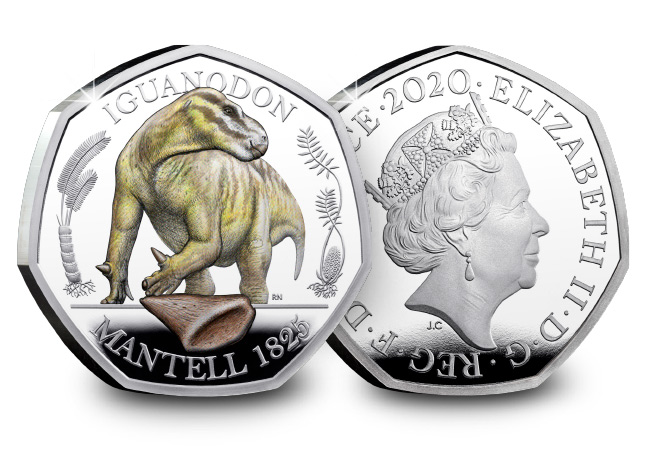
You’ll see that the 50p design credits Mantell with the discovery in 1825, and also depicts the tooth that originally sparked the naming of the creature as an Iguanodon.
Hylaeosaurus
And last, but no means least is the Hylaeosaurus, the third dinosaur to be officially discovered and scientifically named.
Out of the three first dinosaurs to be discovered, it is the Hylaeosaurus’ anatomy that we know the least about as little remains have been uncovered. It is thought that the Hylaeosaurus was a herbivorous, armoured creature, around five meters long with spikes along its back. Its name means ‘woodland lizard’ and is in the same family as the Stegosaurus.
It was again Dr Gideon Mantell who can be credited with the discovery of the Hylaeosaurus. The first remains of the creature were found in Sussex in 1832, and astonished Mantell because the discovery was the most complete non-aviation dinosaur skeleton known at the time. The discovery included several spikes and armour plates, for which this dinosaur is now known. But it wasn’t until 1833 that Mantell published his findings, and the creature was officially named Hylaeosaurus.
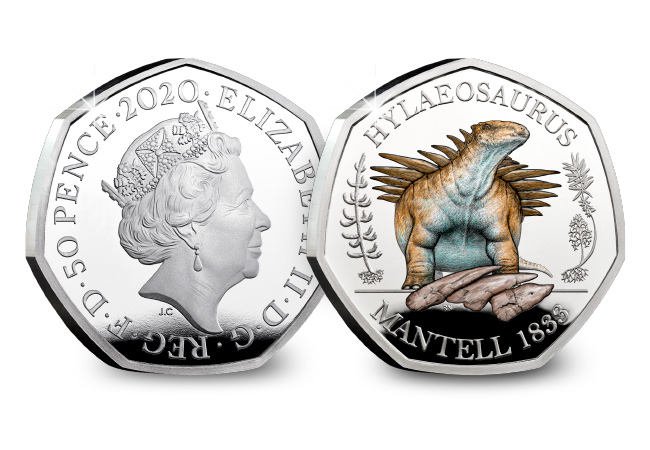
The design of the 50p again incorporates important details about the discovery of the Hylaeosaurus. You’ll see Mantell is noted alongside the year of discovery, 1833, and the initial spikes that were discovered as part of the first skeleton.
If you’re interested…
The Dinosaur 50p series has proven tremendously popular with collectors, not least because this is the first time dinosaurs have ever featured on UK coinage. That said, it’s been the Coloured Silver Proof 50ps that have stolen the show.
We’re lucky to be able to offer a select number of collectors the chance to secure the Complete Silver Dinosaur 50p Collection today. Importantly, we’ve seen precious metal sell-outs across the range, so this is likely to be your only opportunity to secure ALL THREE Dinosaur 50ps in superior Silver Proof quality. Click here to find out more >>
The secrets hidden in Britain’s most secure banknote yet
Whether you love them or hate them, it’s fair to say that when the Bank of England issued the very first polymer banknotes, UK currency was revolutionised. As well as refreshing the designs of the notes, these polymer versions were considered a cleaner, safer and stronger alternative.
In 2016 it was the £5 that received the first makeover, and Winston Churchill was selected to feature on the note. Jane Austen soon followed on the £10 note and now, as chosen by the British public, renowned artist JMW Turner graces the new £20 polymer note.
But it’s not only the design that makes this note special. You see, the Bank of England have described this note as the most secure banknote yet. So, I’m of course curious to see what special security features have been worked into the design of our newest banknote…
Britain’s most secure banknote
Before the revolutionary polymer £20 came along, there were over 2 billion £20 paper notes in circulation. The sheer volume of them made the £20 note Britain’s most used, and consequently most forged, banknote.
So it’s understandable that the need to make it difficult to counterfeit was at the forefront of the designer’s mind! The result? A whole host of special features that make it harder to forge and stand out from other notes in circulation.
Let’s take a closer look at some of the security features incorporated into the design:
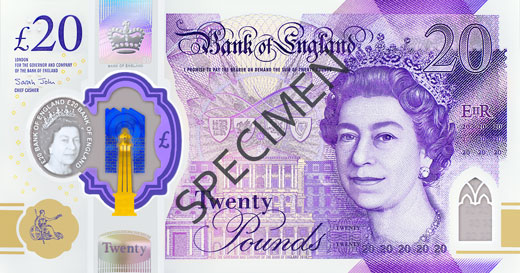
- Transparent windows – the foil in the large see-through window is blue and gold on the front, and silver on the back. Plus, there’s a second, smaller window in the bottom corner.
- Changing holograms – the hologram beneath the large clear pane will alternate between reading ‘Twenty’ and ‘Pounds’ depending on what way you tilt the note.
- The Queen’s portrait in the transparent window – the Queen’s portrait is printed on the window with ‘£20 Bank of England’ printed twice around the edge.
- Foil patches – a silver foil patch contains a 3D image of the coronation crown. There is a second purple foil patch which contains the letter ‘T’.
- Ultra-violet technology – under UV light, the number ’20’ appears in bright red and green on the front of the note, against a duller background.
- Raised dots – you’ll find three clusters of raised dots in the top left hand corner. This tactile feature helps blind and partially sighted people identify the value of the note.
JMW Turner design
When choosing the design for the £20 note, the Bank of England were spoilt for choice. They received over 29,000 nominations submitted by the general public. And the choice to select JMW Turner makes him the first British artist to ever feature on a UK banknote.
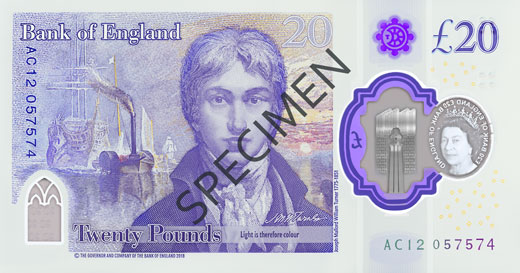
The note itself features Turner’s 1799 self-portrait, which is currently housed in the Tate Modern in London. And behind this you’ll notice one of his most recognisable works – The Fighting Temeraire. This famous painting is a tribute to the ship that played a pivotal role in in Nelson’s victory at the Battle of Trafalgar in 1805.
The final nod to Turner in the design comes from the quote “light is therefore colour”, alongside the signature taken from his will. The quote is taken from a lecture Turner gave in 1818 and is a reference to his innovative use of light, shade, colour and tone.
What do you think about the new £20 Polymer note? Let us know in the comments!
If you’re interested…
If you’re looking for a way to own this significant, revolutionary piece of British currency, then look no further than the UK 2020 £20 Polymer Banknote DateStamp™ issue. Each DateStamp™ issue has been postmarked by Royal Mail with the note’s first day of release – 20th February 2020 – forever ensuring its provenance.
First issues are always valued by collectors and by owning the DateStamp™ issue you will be one of just 2,500 collectors able to forever mark the date the new £20 polymer banknote entered circulation. We have a limited number available, so click here to find out more >>


